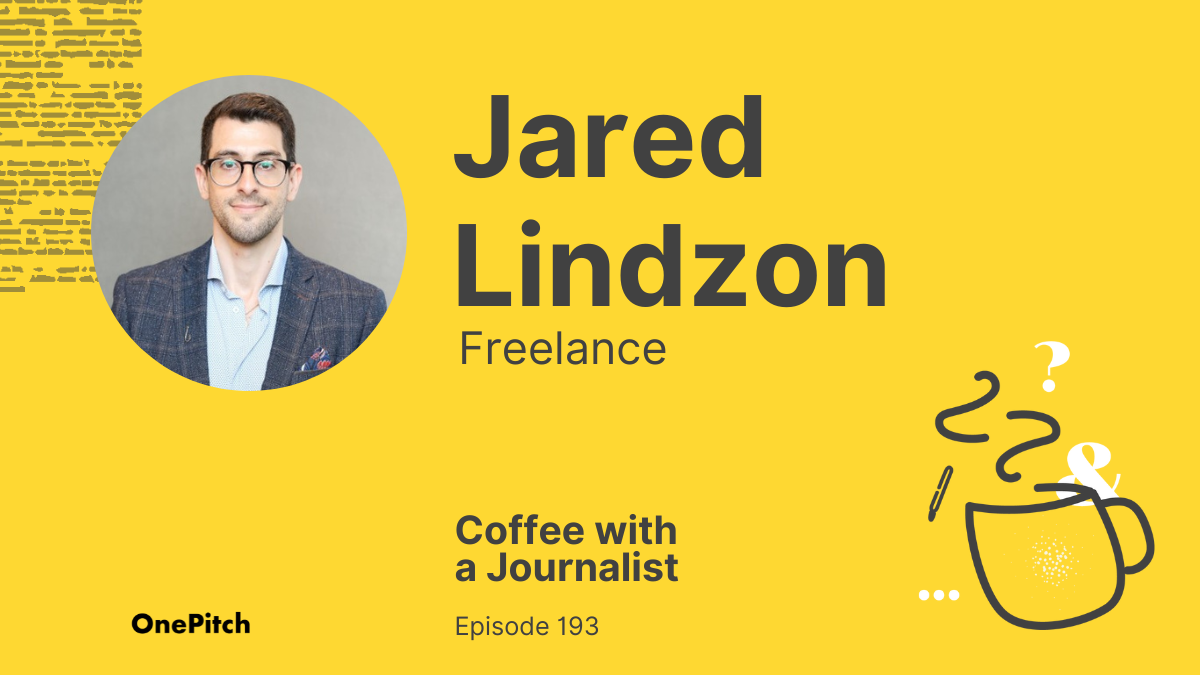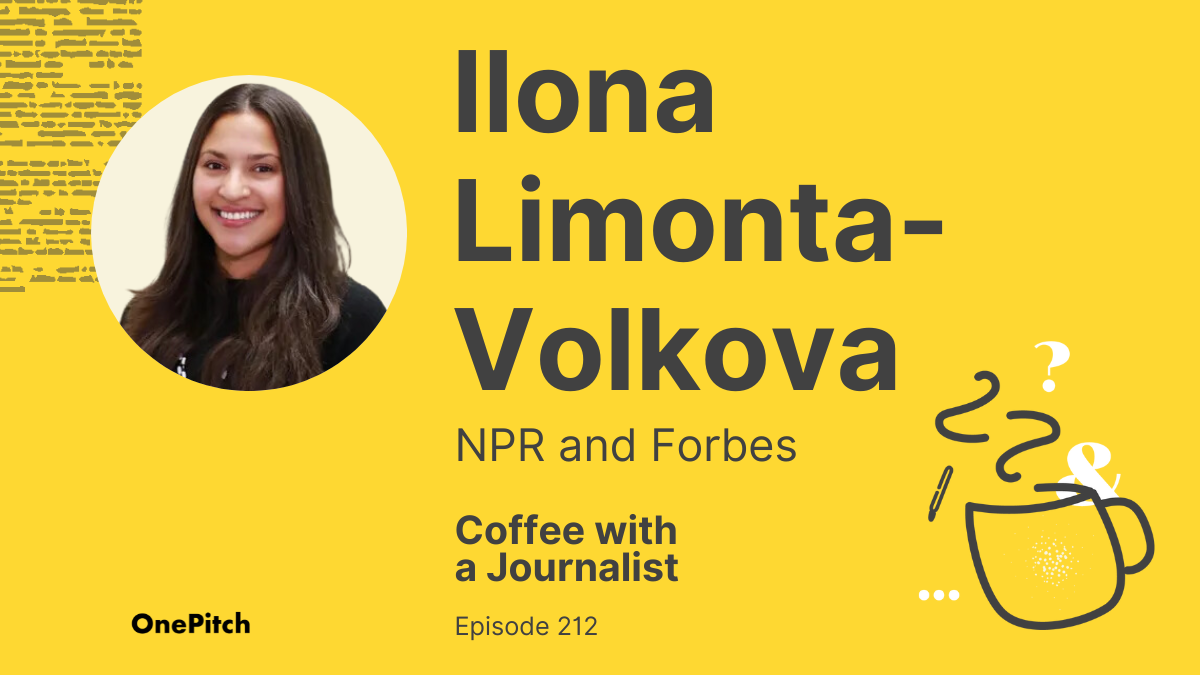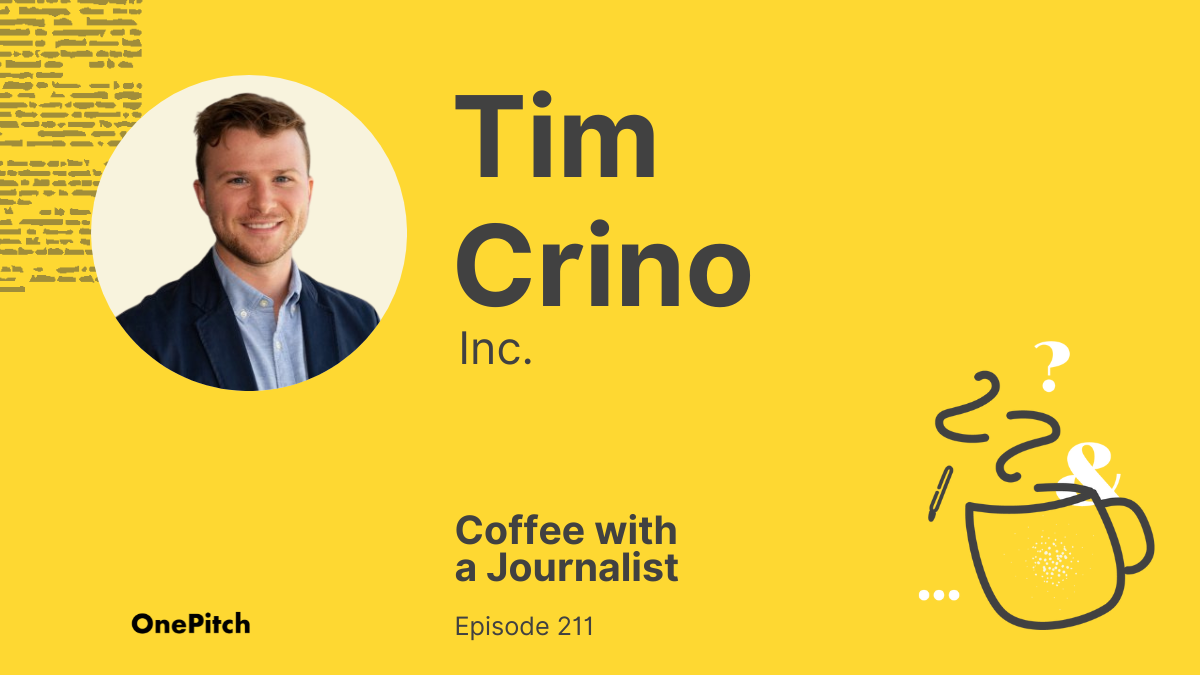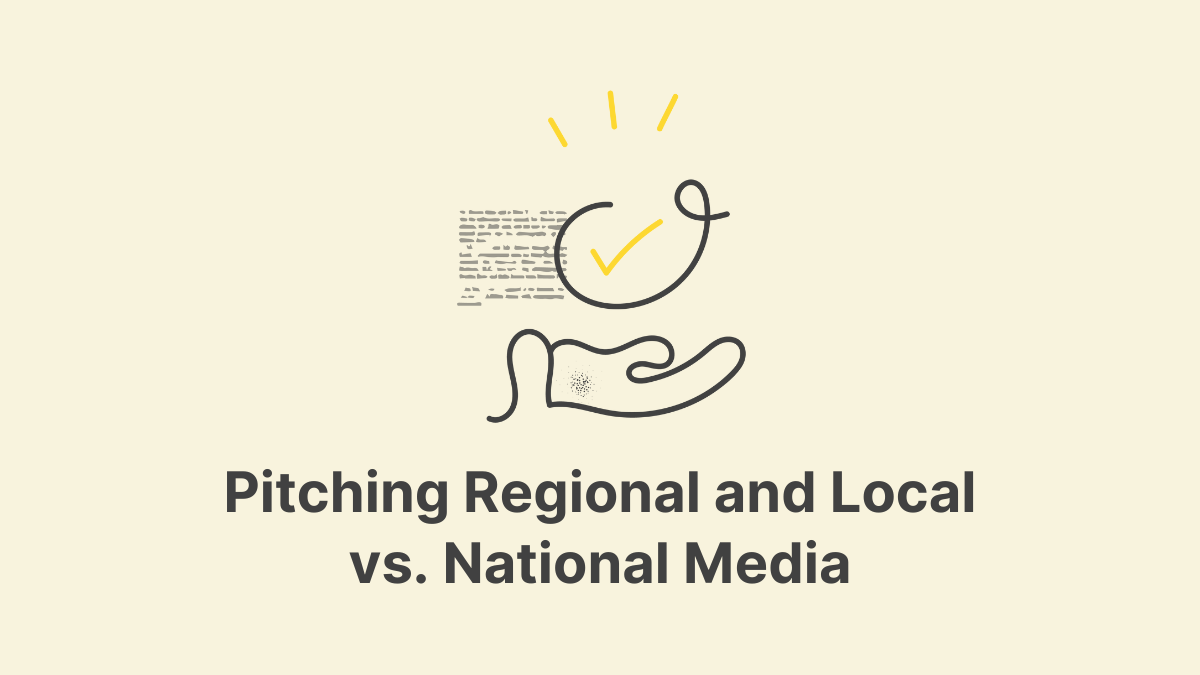Ilona Limonta-Volkova is the host of Money Memories, an NPR podcast, as well as a contributing...
×
Coffee with a Journalist: Jared Lindzon, Freelance
- 11/28/2023
- OnePitch
- Media Insights
Jared Lindzon is a freelance journalist writing about the future of work for publications such as The Globe and Mail and Fast Company's work-life section. Occasionally, he'll also cover personal finance, tech, entrepreneurship, ESG, and small businesses.
During the episode, Jared talks about setting pitches aside to run past his editors, his pre-pitch checklist, why embargoes don't tend to land well with his beat, and more.
Follow her on Twitter and LinkedIn.
Click below to listen to the full conversation and read below for highlights from the interview:
A Freelancer's Role and Pitch Review Process
[0:01:40] BB: Yes. Jared, now you are a bit unique from what our typical person is on the show,
which is usually the full-time reporter who's only at whatever beat at Bloomberg, or something
like that. Being a freelancer is quite different. How would you first describe the work that you
touch?
[0:01:59] JL: Oh, boy. There's a lot to unpack there, so I'll try and be brief. Yeah, freelancing is
definitely a separate animal from your average reporter. I work with a heck of a lot of editors in
all different parts of the world, in all different kinds of publications. Earlier today, I published a
story in the BBC. Last week, I was in Fast Company. In between, I write a lot for the Globe and
Mail here in Canada. I have a few specific beats that I hit pretty often, but as a freelancer, I'm
pretty open to opportunities of all shapes and sizes.
On the pitching side of things, I typically look for pitches that are pretty specific to the contacts
that I have, because it's a little bit more of a lift to try and tackle a whole new area of reporting
that I don't already have existing relationships with editors in. However, particularly enticing
opportunities will encourage me to pitch like crazy if there is something that is really interesting,
or a really interesting experience that I want to try, that I'm going to try and match with the
appropriate editor on my end.
Anyway, that is all to say that how I operate in terms of the stories that I work on is pretty
different from your average reporter. The reporting process itself, however, should be at least
pretty identical.
[0:03:26] BB: Maybe illuminate for folks who aren't as familiar. If they send a pitch to you, do
you then have to pitch it further to the right outlet and so forth? Is that typically how you work?
[0:03:37] JL: Correct. Yes. The way I typically choose to handle that and others might have a
different process, I get a lot of pitches every week to say the least, and the ones that really – if
it's a busy week, usually I just put the good ones aside and then email my editor at the end of
the week a menu of here are the three, or four, or five things that really caught my eye this
week, and then they will turn around and give me a green light on one, maybe two if they like
the ideas. That is how I operate in – I'm busy, but as a freelancer, there's lots of ebbs and flows.
In most jobs, quiet time is appreciated. As a freelancer, quiet time is panic time. When I'm in
panic time, I'm getting a lot of pitches and I'm sending out a lot of pitches in a panic to try and
get some work before I start worrying about making rent.
Managing Pitch Rejections
[0:08:20] BB: Okay. Good intel to have. I think I can ask this of you, because you're in a unique
spot of also getting the rejections from maybe editors. What do you do when you're like, “Ah,
okay, that one struck out. That didn't work.” How do you receive a rejection and pivot from
there? Is it just moving on, or you'd pitch them something else next week? Or, just given that
you also do pitching yourself?
[0:08:46] JL: Totally. I will say, the first couple of years of freelancing are by far the hardest. It
gets a lot easier with time once you have relationships. At the beginning of my career, I'm now
10 years deep, years one and two were defined by rejection. Right now, it's less of a hard no
and more of a conversation about why it didn't work. I'm getting much more detailed responses
now, because I have established relationships. Back in the day, I made it my goal to be rejected
on a regular basis, because I thought that the rejections would all get me closer to where I
wanted to be in my freelance career. That was true. I pursued rejection, knowing that if I had a
one in a hundred chance, I need to get a hundred pitches out there.
Yeah. I think, I got really resilient, which is important for any freelancer, especially in the early
days. Then over time, through these relationships with editors, some of which have lasted the
entire duration of my freelance career. There's some folks I've been working with for a whole
decade now and others, certainly a few years on average. There's a little bit more of a back and
forth. Often, I get a reason why a pitch is declined. Maybe that's something that I benefit from
that most pitchers don't get in response. It's more of a dialogue these days than just a hard no,
or a no response.

Want to pitch Jared and other journalists like him?
Click below to sign up for OnePitch and use these insights in your next pitch!

Jared's Take On What Makes A Great Pitch
[0:10:09] BB: Got you. You did pick, I know Jared, a pitch that really resonated with you. Do
you want to share and elaborate with us?
[0:10:17] JL: Yeah. Well, before I came on, I did a quick look at the last five or six stories that I
have pitched. I'm sorry, that I've published, and only one of them came from a pitch.
[0:10:30] BB: Oh, shoot.
[0:10:31] JL: Yeah. I don't know what that means exactly.
[0:10:34] BB: Well, tell us more.
[0:10:36] JL: I mean, that's not an average. That just happens to be at this particular moment. I
look to see, yeah, which pitches have been successful lately and there's only been one and not
only did that pitch result in a story, it actually resulted in two stories. I thought that that was
particularly unique. This pitch was from Forrester. It checks a lot of the boxes for me, because it
basically, it's a very brief pitch. It’s one opening sentence. It is three trends that are in bold, and
so data to back up those trends. Then just a quick note, if you want to copy the report, let me
know. Yeah. For me, that's a home run. That knocks it out in the park.
[0:11:23] BB: Perfect. I love that it's one line, build a point, data with all the things.
[0:11:29] JL: Yeah, exactly. Like I said, from that came not one, but two stories. One has
already been published and the other is coming out in a little while.
Staying Organized With Follow Ups
[0:14:36] JL: There's something about it that just clicking just doesn't do it.
[0:14:40] BB: The click is not satisfying. No. The crossing out, by the way, do you use a thick
marker, or a thick pen?
[0:14:47] JL: I have a designated pen for all of these. Yeah. No, it's a good, thick, black pen. I
literally have a pad of paper next to my desk at all times. Legal pad. Every week gets its own
page. On the left side is my to-do list. On the right side is the days of the week written out with
individuals to-do lists under each. In that to-do list, if I send a pitch on, let's say, a Friday, I put a
note on my calendar, follow up with this editor on Tuesday, or whatever. Assuming I haven't
heard from them, I have that item in my to-do list now to make the follow up. That's how I keep
myself organized.
[0:15:28] BB: I swear, half of tasks seem to be just the follow-ups.
[0:15:32] JL: Yes. Like I said, over the years, that's gotten better for me. When I first started out,
I had to be really on top of following up, because I was pitching like crazy. I was not hearing
back from a lot of the folks that I was working with. Now, most of the editors, again, I've been
working with them for years and years, and they do get back to me eventually almost all of the
time. I know the editors well enough that this editor might take a week. This other editor usually
takes two days. If it's been three days for that editor that normally takes two days, it's worth a
nudge. But the editor who normally takes a week, I'm not going to bother her until a full week
has passed.
[0:16:09] BB: Mm-hmm. Because you got to know the little ins and outs and everything. Mm-
hmm.
[0:16:13] JL: Exactly. Takes a little while to get used to that sort of rhythm.
Rapid Fire Pitching Preferences
[0:18:46] BB: That's right. Perfect. Okay. Could you then go through this rapid-fire question for
us, or question list? Here we go. Video, or phone interview?
[0:18:56] JL: Almost no preference, unless it's early in the morning, or late in the evening, in
which case, I don't want anyone to see my face.
[0:19:01] BB: Honest answer. Bullet points, or paragraphs?
[0:19:04] JL: Bullet points.
[0:19:05] BB: Short, or long pitches?
[0:19:07] JL: Short. Probably, short.
[0:19:08] BB: Always short.
[0:19:09] JL: Short with an opportunity to dive in elsewhere, if needed. A short pitch followed by
a formal press release, a link to a study, somewhere where if the short pitch interests me, I can
learn more without having to email back. That's my preferred mode.
[0:19:24] BB: Okay. Okay. Fair enough. Images attached, or Dropbox zip file?
[0:19:30] JL: Don't send me images.
[0:19:33] BB: Okay. Perfect. NA.
[0:19:35] JL: Yeah. Just because you're taking up a lot of space in my inbox and again, by the
nature of what I report on, images are almost never necessary, at least until later on in the
reporting process.
[0:19:47] BB: Good point. How about Twitter, or X DM, or just email?
[0:19:52] JL: I respond to both if I know you and we follow each other, which I think is a
requirement anyway. Feel free to hit me with a quick DM. But generally speaking, email is
preferred.
[0:20:03] BB: Got you. One follow-up, or multiple?
[0:20:06] JL: One follow-up. Yeah. Like I said, I keep my inbox at zero unread. I will
acknowledge the email and look at it at least briefly before deleting it. I don't have time to
respond to everything, but I do look at everything. It's very unlikely that the follow up is going to
change my mind. Less is more.
[0:20:26] BB: Less is more. Direct, or creative subject lines?
[0:20:30] JL: Depends on the content. It's a cop out, but it really does.
[0:20:35] BB: Okay. Press release, or media kit?
[0:20:38] JL: Press release. Just give me the facts. I don't want to go digging through a pile of
headshots and corporate stats to find it.
[0:20:45] BB: Mm-hmm. Particular time you read pitches? Sounds like, it's all the time.
[0:20:50] JL: Yeah. When work is slow, which is anybody's guess.
[0:20:55] BB: Fair enough, fair enough. Then lastly, are there any sources you are particularly
interested in hearing from, or need?
[0:21:03] JL: Are we looking for specific names and organizations, or just broad categories of
folks that I'd like to hear from?
[0:21:09] BB: Usually, I was thinking broad categories, but yeah, you got some names.
[0:21:12] JL: I don't have any names. No, I definitely don't want to be inviting anybody. I would
say, one area that could do a better job of pitching is academia.
[0:21:23] BB: Okay.
[0:21:24] JL: There's a lot of self-serving data in the corporate world. Not saying it isn't good
data. Some of the time, good insights. But the academia tends to be more neutral, tends to have
a little bit – carries more weight in the newsroom for sure in academic study, versus a survey
monkey survey that a company put out with leading questions to serve their purposes.
Academia, but they don't really have the infrastructure to pitch, because it's not as much in their
interest. I would say, I would love to hear more from academics and academic institutions that
are the areas that I'm reporting on.
________
For more great 1:1 conversations with journalists from top-tier outlets, subscribe to the Coffee with a Journalist podcast to get the latest episode drops. Also, don’t forget to follow us on Twitter for other updates on our newest PR tips, tools, and best practices.
Want more tips from journalists?
Fill out the form below to subscribe to Coffee with a Journalist and receive weekly emails highlighting reporters, journalists, and editors and their individual pitching preferences.
Related Posts
Tim Crino is a senior editor at Inc. where his coverage focus is on cybersecurity and data privacy....
In the world of public relations, it’s no secret that tailoring your pitchrather than blasting out...
Newsletter Form
Recent Posts
About Us
OnePitch was created by a handful of
tech-savvy publicists and journalists
who believe that the PR industry is
long overdue for some innovation.
We’re changing this with OnePitch.







